Transcription of Boson TCPIP Cheat Sheet www.boson.com Subnetting Study …
1 Boson TCP/IP Cheat Subnetting Study Guideby Boson Software, LLCAn octet is a binary number of 8 bits, with the lowest possible number being 00000000 and the highest possible number being 11111111, or 28. The binary number 11111111, or 28, converts to 255 in decimal format. Table Address Class SummaryClassNumber of SubnetsNumber of Hosts Per SubnetRange of Network IDs (First Octet)Class A 26 6,777,2 4 26 Class B 6,38465,534 28 9 Class C2,097, 52254 92 223 The First-Octed Rule: High-Order Bits Determine the Address ClassThe decimal number in the first octet, or the high-order bits, represents the network ID for the address, and that network ID remains the same for all hosts on that network segment.
2 High-order bits, which are also called the most significant bits, are those in the left-most portion of the binary address. The remaining octets act as host IDs. Address classes are categorized based on the decimal number in the first octet, as seen in Table 1, the Address Class Summary 2 ClassBinary StartBinary EndFirst OctetMost Significant BitsSpecial NoteClass A0000000101111111 26*0 AssignableClass B1000000010111111 28 9 10 AssignableClass C1100000011011111 92 223110 AssignableClass D1110000011101111224 2391110 MulticastClass E1111000011111111240 25511110 InterNIC*Addresses beginning with 127 are used for loopback testingTable 3 ClassTotal Number of Subnets Per ClassEquationSubnetsClass 27 2 = 4 2 = 6, 2 = 2,097.
3 4 ClassTotal Number of Hosts Per SubnetEquationHostsClass 2 = 6,777,2 6 2 = 65, 28 2 = TCP/IP Cheat 5 Reserved Address Space*RFC 66 and 9 8 = Private Address Space (Internal Use Only)NetblockSpecial UseReference 9 8 72.( 6 3 ). 9 8 .xBackbone Test CRH6 Test CJBP (3 255).xUnassignedNIC 92..(0 ).xBackbone Local NetsSGC 92.. Apollo NetsSGC 92. 9 8 Converting Decimal into Binary . Create a chart with eight In the first row, enter 1 in the far right column. Moving to the left, double the preceding value to enter 2 in the next column, 4 in the next column, 8 in the next column, Continue in that manner until all columns in the first row contain a value.
4 The column on the far left should contain the value 128. These values are called weighted Beginning with the left-most weighted value, subtract each weighted value from the decimal being converted to binary until you reach the largest weighted value that can be subtracted without yielding a negative result. Enter a 1 as the binary value for that weighted value, and enter a 0 as the binary values for the weighted values that yielded negative results. 5. After reaching the largest weighted value that can be subtracted from the decimal without yielding a negative result, subtract the next weighted value from the remainder of the previous weighted value, not from the decimal.
5 If a subsequent weighted value yields a negative result, enter a 0 as the binary value and subtract the next weighted value from the remainder yielded by the last successful subtraction (Note: See Weighted Values 2 and in Table 6 below for an example). 6. Table 6 below illustrates the conversion of the decimal 29 into binary:Table 6 Most Significant BitLeast Significant BitWeighted Values 286432 6842 Subtraction from Decimal29 28 = 9929 64 = 3529 32 = 329 6 = 3 3 8 = 55 4 = 2 = 1 = 0 Binary000111017.
6 The decimal 29 converts into binary as TCP/IP Cheat Binary into Decimal . Create a chart with eight In the first row, enter 1 in the far right column. Moving to the left, double the preceding value to enter 2 in the next column, 4 in the next column, 8 in the next column, Continue in that manner until all columns in the first row contain a value. The column on the far left should contain the value 128. These values are called weighted Enter the binary value in the chart below the weighted values so that there is one 0 or one 1 below each weighted Add together all weighted values that have 1s below Table 7 below illustrates the conversion of the binary 11000011 into decimal:Table 7 Most Significant BitLeast Significant BitWeighted Values1286432 68421 Binary110000117.
7 The binary 11000011 converts into the decimal 95 ( 28 + 64 + 2 + = 95).SubnettingSubnetting allows a large network block to be logically subdivided into multiple smaller networks, or subnets. The use of multiple smaller networks allows the use of varying physical networks, such as Ethernet or Token Ring, which could not otherwise be combined. Additionally, the smaller subnets can improve the speed of traffic and permit easier masks provide the logical segmentation required by routers to be able to address logical subnets.
8 A default gateway IP address on a router interface allows clients to access networks outside their local subnets. The number of bits used in a subnet mask determines the number of subnets to RememberSubnet masks cannot contain all 0s or all s in either the host portion or the network portion of the Zero, which contains all 0s, can be used sometimes. It is not s Subnet, which contains all s, can never be incremental value is the IP host address starting point for the incremental value represents another logical only use the network ID and the subnet only use the IP address on the clients local subnets and the clients subnet bit represents a power of 2.
9 Boson TCP/IP Cheat 8 Binary MaskDecimal MaskBinary HostsBits UsedNumber of SubnetsValid Host Imcrements000000000000000000 Net IDNot a subnet10000000 28*00000001 28*11000000 9200000011226411100000224000001113632111 10000240000011114 4 6111110002480001111153081111110025200111 111662411111110254*011111117 262*11111111255*111111118254 ** Seven subnets are valid for Class A or B in the first octet. Class C has five valid subnets; the last two subnets are each a binary of AddressingAll subnets can be categorized into seven ranges with three classes each (Class A, Class B, and Class C).
10 Table 9 Class AMaximum Number of SubnetsCalculation for Host IDMaximum Number of Hosts Per SubnetSubnet MaskSubnet Bits RequiredHost Bits AvailableRange0224 2 6,777,2 Class A 223 2 Invalid 28 = Subnet 0 23 Not Recommended2222 24, 94,302255. /7622 22,097, Range 2/7 4220 2 ,048, 3/7302 9 2524, 9 Range 4/7622 8 2262, 8 Range 5/7 282 7 2 3 , 7 Range 6/7 Boson TCP/IP Cheat 0 Class BMaximum Number of SubnetsCalculation for Host IDMaximum Number of Hosts Per SubnetSubnet MaskSubnet Bits RequiredHost Bits AvailableRange02 6 265, 6 Class A Range 7/7 & Begin Class B 2 5 2 Invalid 28 = Subnet 09 5 Not Recommended22 4 2 6, 0 4 Range /762 3 28, 3 Range 2/7 42 2 24, 2 2 Range 3/7302 22, 3 Range 4/7622 0 2.











